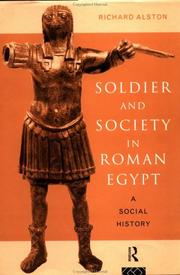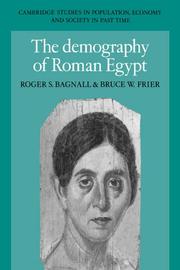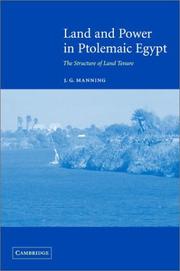| Listing 1 - 6 of 6 |
Sort by
|
Book
ISBN: 0714109428 0520059301 9780520059306 9780714109428 Year: 1986 Publisher: Londres British Museum Publications
Abstract | Keywords | Export | Availability | Bookmark
 Loading...
Loading...Choose an application
- Reference Manager
- EndNote
- RefWorks (Direct export to RefWorks)
Egypt --- Egypte --- History --- Histoire --- História do egito. --- Civilização egípcia. --- Geschichte 332 v. Chr.-642. --- Ägypten (Altertum) --- Civilization --- Ägypten (Altertum). --- Égypte --- Civilisation --- 332 av. J.-C.-640

ISBN: 0415122708 9780415122702 Year: 1995 Publisher: London New York Routledge
Abstract | Keywords | Export | Availability | Bookmark
 Loading...
Loading...Choose an application
- Reference Manager
- EndNote
- RefWorks (Direct export to RefWorks)
Sociology, Military --- Sociologie militaire --- History --- Histoire --- Egypt --- Karanis (Extinct city) --- Rome --- Egypte --- Karanis (Ville ancienne) --- Army --- Armée --- -Military sociology --- Armed Forces --- Armies --- Peace --- War --- War and society --- Karanis (Egypt) --- -Army --- -History. --- Antiquities --- Soldiers --- Italy --- ANTIGUIDADE (HISTÓRIA) --- Militaires romains --- Gesellschaft --- Militär --- Römerzeit --- Veteran --- Krijgsmacht. --- Romeinse oudheid. --- History. --- Rome. --- Histoire. --- Geschichte 31 v. Chr.-500. --- Sozialgeschichte 31 v. Chr.-395. --- EGITO (HISTÓRIA;ASPECTOS SOCIAIS) --- Ägypten (Altertum) --- Ägypten --- Égypte --- Rome. Armée --- Karanis (ville ancienne). --- Colonies --- Civilisation --- Egypt. --- Italy. --- Gesellschaft. --- Militär. --- Römerzeit. --- Veteran. --- Karanis (Extinct city). --- EGITO (HISTÓRIA;ASPECTOS SOCIAIS). --- Ägypten (Altertum). --- Ägypten. --- -History --- -Armed Forces --- Military sociology --- Armée --- Sociology [Military ] --- 30 B.C.-640 A.D. --- Rome - Army - History. --- Egypt - History - 30 B.C.-640 A.D.

ISBN: 0521461235 9780521461238 9780521025966 0521025966 9780511584053 0511092229 0511584059 0511885261 Year: 1994 Volume: 23 Publisher: Cambridge: Cambridge university press,
Abstract | Keywords | Export | Availability | Bookmark
 Loading...
Loading...Choose an application
- Reference Manager
- EndNote
- RefWorks (Direct export to RefWorks)
The traditional demographic regime of ancient Greece and Rome is almost entirely unknown; but our best chance for understanding its characteristics is provided by the three hundred census returns that survive on papyri from Roman Egypt. These returns, which date from the first three centuries AD, list the members of ordinary households living in the Nile valley: not only family members, but lodgers and slaves. The Demography of Roman Egypt has a complete and accurate catalogue of all demographically relevant information contained in the returns. On the basis of this catalogue, the authors use modern demographic methods and models to reconstruct the patterns of mortality, marriage, fertility and migration that are likely to have prevailed in Roman Egypt. They recreate a more or less typical Mediterranean population as it survived and prospered nearly two millennia ago.
Egypt --- Population --- History --- Census --- Recensement --- Historia antiga --- Historia antiga (povos) --- Bevolkingsontwikkeling. --- Volkstellingen. --- Bevölkerungsstruktur. --- Geschichte 11 v. Chr.-258. --- Demographie. --- Römerzeit. --- Bevölkerung. --- Geschichte 31 v. Chr.-300. --- egito. --- Historia antiga (povos). --- Roman Empire. --- Demography --- Demography. --- Démographie --- Egypt. --- Geschichte. --- Marriage --- Roman World --- Social Conditions --- Egito. --- Ägypten (Altertum). --- Égypte --- History. --- Égypte --- Ägypten --- Egitto --- Egipet --- Egiptos --- Miṣr --- Southern Region (United Arab Republic) --- Egyptian Region (United Arab Republic) --- Iqlīm al-Janūbī (United Arab Republic) --- Egyptian Territory (United Arab Republic) --- Egipat --- Arab Republic of Egypt --- A.R.E. --- ARE (Arab Republic of Egypt) --- Jumhūrīyat Miṣr al-ʻArabīyah --- Mitsrayim --- Egipt --- Ijiptʻŭ --- Misri --- Ancient Egypt --- Gouvernement royal égyptien --- جمهورية مصر العربية --- مِصر --- مَصر --- Maṣr --- Khēmi --- エジプト --- Ejiputo --- Egypti --- Egypten --- מצרים --- United Arab Republic --- Egypte --- Histoire --- Arts and Humanities --- Egypt - Population - History --- Egypt - Census - History
Book
ISBN: 9782130617686 2130617689 Year: 2013 Volume: 3980 Publisher: Paris: PUF,
Abstract | Keywords | Export | Availability | Bookmark
 Loading...
Loading...Choose an application
- Reference Manager
- EndNote
- RefWorks (Direct export to RefWorks)
L’Égypte antique est inséparable de l’écriture hiéroglyphique. Cette écriture élégante et majestueuse a symbolisé à elle seule la vallée du Nil aux yeux de l’Occident pendant plus de mille cinq cents ans, jusqu’à ce que Champollion déchire, en 1822, le voile de mystère qui l’enveloppait. Jusqu’il y a peu, l’écriture cunéiforme revendiquait l’honneur d’être l’écriture la plus ancienne de l’humanité. La découverte, il n’y a pas si longtemps, de nouveaux documents à Abydos, en Haute Égypte, a mis à mal cette suprématie. En explorant cette langue, c’est donc aussi aux origines de l’écriture que nous touchons. Au-delà de leur beauté formelle, Jean Winand nous invite à percer les sens des hiéroglyphes et à découvrir l’histoire d’une des langues les plus anciennes.
Egyptian language --- Egyptien (Langue) --- Writing, Hieroglyphic --- Ecriture hiéroglyphique --- Hieroglyphics. --- Égyptien ancien (langue) --- Écriture hiéroglyphique --- BPB1309 --- Histoire --- Égypte --- Geschiedenis --- Egypte --- Ecriture hiéroglyphique --- Écriture hiéroglyphique. --- l-Eġittu --- Egjipti --- Egipat --- Egypti --- Egito --- Egitto --- Egypten --- Ägypten --- Egiptas --- Egyiptom --- Egypt --- Egipto --- Egiptus --- Ēģipte --- An Éigipt --- Αίγυπτος --- Egipt --- Египет --- Египат --- Egyptská arabská republika --- Arabska Republika Egiptu --- Arabrepubliken Egypten --- Republica Arabă Egipt --- Αραβική Δημοκρατία της Αιγύπτου --- die Arabische Republik Ägypten --- Arapska Republika Egipat --- Arabische Republiek Egypte --- Арабска република Египет --- Poblacht Arabach na hÉigipte --- Egipto Arabų Respublika --- República Árabe do Egito --- Egyptin arabitasavalta --- Repubblica araba d’Egitto --- Арапска Република Египет --- Den Arabiske Republik Egypten --- Ēģiptes Arābu Republika --- Арапска република Египат --- Egiptuse Araabia Vabariik --- ir-Repubblika Għarbija tal-Eġittu --- République arabe d’Égypte --- Arabska republika Egipt --- Republika Arabe e Egjiptit --- Egyiptomi Arab Köztársaság --- Arab Republic of Egypt --- República Árabe de Egipto --- História --- ιστορία --- storja --- histori --- historie --- historia --- história --- история --- stair --- geschiedenis --- történettudomány --- povijest --- zgodovina --- history --- историја --- Geschichtswissenschaft --- storia --- istorija --- ajalugu --- vēsture --- istorie --- Geschichte --- historiografie --- storiografia --- dějiny národů --- historiador --- dějepis --- historická věda --- történelem --- Hieroglyphics --- Égypte
Book
ISBN: 1789695961 1789695953 9781789695953 9781789695960 Year: 2019 Publisher: Oxford : Archaeopress Publishing Ltd,
Abstract | Keywords | Export | Availability | Bookmark
 Loading...
Loading...Choose an application
- Reference Manager
- EndNote
- RefWorks (Direct export to RefWorks)
The Festivals of Opet, the Valley, and the New Year: Their socio-religious functions compares the religious and social functions of these three Festivals, the first two of which were often regarded by the Egyptians as a pair; the New Year Festival stands out on account of its corpus of surviving material and importance. Until now, detailed study of the New Year Festival has only been carried out with reference to the Greco-Roman period; this study turns its attention to the New Kingdom. The book analyses the broad perspectives that encompass Egyptian religion and cult practices which provided the context not only for worship and prayer, but also for the formation of social identity and responsibility. The festivals are examined in the whole together with their settings in the religious and urban landscapes. The best example is New Kingdom Thebes where large temples and burial sites survive intact today with processional routes connecting some of them. Also presented are the abundant written sources providing deep insight into those feasts celebrated for Amun-Re, the king of the gods. The volume also includes a list of dated records which provides a concordance for the Egyptian calendars.
Rites and ceremonies --- Egypt --- Religious life and customs. --- Religion. --- Ceremonies --- Cult --- Cultus --- Ecclesiastical rites and ceremonies --- Religious ceremonies --- Religious rites --- Rites of passage --- Traditions --- Ritualism --- Manners and customs --- Mysteries, Religious --- Ritual --- Égypte --- Ägypten --- Egitto --- Egipet --- Egiptos --- Miṣr --- Southern Region (United Arab Republic) --- Egyptian Region (United Arab Republic) --- Iqlīm al-Janūbī (United Arab Republic) --- Egyptian Territory (United Arab Republic) --- Egipat --- Arab Republic of Egypt --- A.R.E. --- ARE (Arab Republic of Egypt) --- Jumhūrīyat Miṣr al-ʻArabīyah --- Mitsrayim --- Egipt --- Ijiptʻŭ --- Misri --- Ancient Egypt --- Gouvernement royal égyptien --- جمهورية مصر العربية --- مِصر --- مَصر --- Maṣr --- Khēmi --- エジプト --- Ejiputo --- Egypti --- Egypten --- מצרים --- United Arab Republic --- Ritos y ceremonias --- Fiestas religiosas --- Egipto --- Egito --- Usos y costumbres --- Vida religiosa --- Religión --- Religion --- Sacred space

ISBN: 0521819245 0521044308 9780521819244 0511179294 0511061536 051105520X 0511326106 0511482841 1280430583 1139148788 0511069995 9780511482847 9780521044301 1107135729 9780511061530 9780511055201 9781280430589 9780511069994 9786610430581 6610430586 9781139148788 Year: 2003 Publisher: Cambridge ; New York : Cambridge University Press,
Abstract | Keywords | Export | Availability | Bookmark
 Loading...
Loading...Choose an application
- Reference Manager
- EndNote
- RefWorks (Direct export to RefWorks)
This history of land tenure under the Ptolemies explores the relationship between the new Ptolemaic state and the ancient traditions of landholding and tenure. Departing from the traditional emphasis on the Fayyum, it offers a coherent framework for understanding the structure of the Ptolemaic state, and thus of the economy as a whole. Drawing on both Greek and demotic papyri, as well as hieroglyphic inscriptions and theories taken from the social sciences, Professor Manning argues that the traditional central state 'despotic' model of the Egyptian economy is insufficient. The result is a subtler picture of the complex relationship between the demands of the new state and the ancient, locally organized social structure of Egypt. By revealing the dynamics between central and local power in Egypt, the book shows that Ptolemaic economic power ultimately shaped Roman Egyptian social and economic institutions.
Egyptian language.
---
Land tenure.
---
Ptolemaic dynasty.
---
Real property.
---
Land tenure
---
Egyptian language
---
Real property
---
Business & Economics
---
Real Estate, Housing & Land Use
---
History
---
Papyri, Demotic
---
Ptolemaic dynasty,
---
Egypt
---
Economic conditions
---
Antiguidade.
---
Civilização egípcia (aspectos econômicos)
---
Grundeigentum.
---
Papyrus.
---
Verwaltung.
---
Grondbezit.
---
Pacht.
---
Politieke structuur.
---
Ptolemaeën.
---
Sociaal-economische aspecten.
---
Papyri, Demotic.
---
History.
---
Egito Ptolomaico.
---
Demotisch.
---
Ägypten
| Listing 1 - 6 of 6 |
Sort by
|

 Search
Search Feedback
Feedback About UniCat
About UniCat  Help
Help News
News